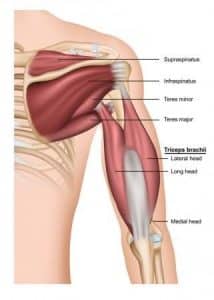You are not alone if you only have some vague idea of what a rotator cuff tear is. Yes, it means you’ve injured your shoulder but there is more to it than that. The rotator cuff is made up of four tendons and muscles that help keep your shoulder joint in place in the socket. 
Rotator cuff tears are common injuries. In part, because the tendons have a tight space in which to move, so they sometimes rub against the acromion (bony area) above them or against ligaments in the shoulder. Rotator cuff tears can involve one or more of the four tendons and can either be partial tears or what is called full-thickness tears. The most common rotator cuff tear is a tear of the supraspinatus tendon. Rotator cuff tears can be acute (sudden) or degenerative, meaning they develop over time from overuse/general wear and tear.
Symptoms of a rotator cuff injury can include pain with use of the arm, particularly when raising it. Symptoms also include pain at night when lying on the affected arm, weakness and popping / cracking often listed as “crepitus” in a medical record. Normally, acute rotator cuff injuries involve moderate to intense pain. Rotator cuff injuries that occur over time may not even cause pain, sometimes just weakness.
Acute rotator cuff tears can be caused by striking the upper arm / shoulder against something, falling on the arm with it stretched out and forceful jerking of the arm.
If you believe you’ve sustained a rotator cuff injury through a car wreck or an accident at work, it is very important to your claim to provide your doctors with a detailed information. Instead of saying, “I hurt my shoulder,” explain how you hurt your shoulder; tell what symptoms you experienced and whether they were immediate or delayed; explain what makes your symptoms better or worse; and describe any activities that you were able to do before your accident that you’re no longer able to do. If you’ve treated for shoulder pain in the past, if asked about any prior treatment, be honest and also explain how your symptoms are different now than before.
If your rotator cuff injury wasn’t due to an acute accident but rather from repetitive motion in your job, it is more likely than not that your claim will be denied and require litigation. Workers’ Compensation insurance carriers are very reluctant to accept these types of claims because they are common in the public at large, fraying and even tears are more common as people age, and people repetitively use their arms for tasks outside of work. Rotator cuff injuries due to repetitive motion at work fall under North Carolina General Statute §97-53, regarding occupational diseases. In particular, it falls under subsection 13 which is commonly called the “catch-all provision.” For occupational diseases that fall under the catch-all provision and that includes repetitive motion injuries, it isn’t sufficient for the person with the condition to prove that their job caused or significantly contributed to the development of the condition, a person must also prove that their employment placed them at an increased risk of developing the condition as compared to the general public. Rutledge v. Tultex Corp. 308 N.C. 85, 301 S.E.2d 359.
So what does that added requirement mean? It means that for rotator cuff tears caused by repetitive motion / overuse, you have to prove that your work caused or significantly contributed to your condition AND that the nature of your work makes it more likely that you would develop the condition than other people not in that line of work. Examples are often helpful, particularly for the second requirement. People who paint houses for a living are more likely to develop rotator cuff tears from repetitive motion than people in the general public, because they are constantly moving their arms and do repetitive tasks overhead as well.
